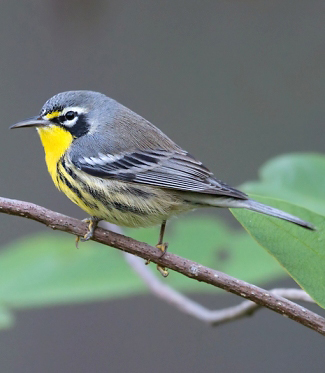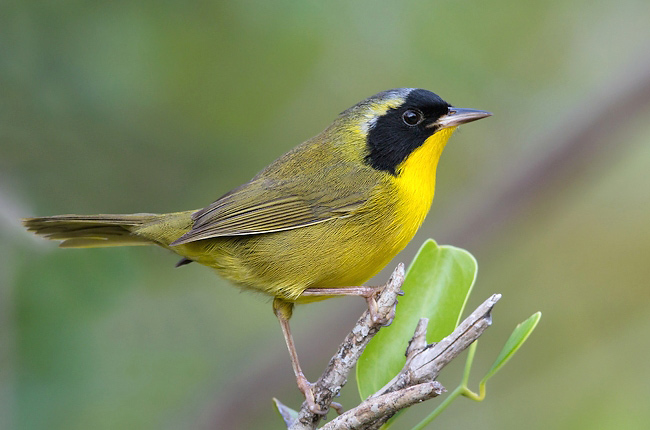

The endemic Bahama Warbler by Dubi Shapiro.
- Eight endemic birds; a hummingbird, a lizard-cuckoo, a swallow, a nuthatch, a thrush, an oriole, a yellowthroat and a warbler
- Wintering Kirtland's Warblers
- Several other spectacular localized birds including West Indian specialities such as Cuban Amazon, Olive-capped Warbler and Western Spindalis
- And some of the world's other most spectacular birds including American Flamingo, White-tailed Tropicbird and Magnificent Frigatebird
- As well as one of the best places in the world to swim with dolphins
- As well as sharks and Sting Rays
- All in some fine island settings

Bahama Yellowthroat by Dubi Shapiro.
Best Birds and other wildlife in the Bahamas
Birds
Endemics 8
Inagua (Bahama) Woodstar (Great Inagua), Bahama Lizard-cuckoo, Bahama Swallow, Bahama (Brown-headed) Nuthatch (endemic to a small area of native pine
forest on the island of Grand Bahama this species was feared extinct after Hurricane Matthew in 2016 and Hurricane Dorian in 2019), Northern Red-legged
Thrush, Bahama (Black-cowled) Oriole, Bahama Yellowthroat and Bahama (Yellow-throated) Warbler.
Near-endemics
Bahamas and Turks & Caicos Islands 1 Bahama Woodstar.
Bahamas and Cuba 3 Cuban Emerald, Cuban Pewee and Olive-capped Warbler.
Bahamas, Cuba and Cayman Islands 3 West Indian Woodpecker, Cuban Amazon and La Sagra’s Flycatcher.
Others
Kirtland’s Warbler (mostly Sep-Apr), American Flamingo (colony on Great Inagua usually present Mar-Jul), White-tailed Tropicbird (mostly late March
to July), Magnificent Frigatebird, and about 20 West Indian specialities including Antillean Nighthawk (mostly May-Aug), Grey (mostly Apr-Oct) and
Loggerhead Kingbirds, Thick-billed Vireo, Bahama Mockingbird, Western Spindalis and Greater Antillean Bullfinch, as well as Brown Pelican, Great Blue
Heron, Turkey Vulture, Red-tailed Hawk, Willet, Laughing Gull, Royal Tern, White-crowned Pigeon, Common Ground Dove, Smooth-billed Ani, Belted Kingfisher
(winter), Hairy Woodpecker, Black-whiskered Vireo (mostly Apr-Aug), Blue-grey Gnatcatcher, Grey Catbird (winter), Pine and Prairie Warblers, Bananaquit,
Black-faced Grassquit and Red-winged Blackbird. Also a chance of Reddish Egret, Limpkin, Black-necked Stilt, Key West Quail Dove, Zenaida Dove, Mangrove
Cuckoo, Yellow (Golden) Warbler and wintering/passage migrant species such as Northern Parula, Black-and-white, Black-throated Blue, Black-throated Green,
Cape May and Prairie Warblers, American Redstart, Ovenbird, Common Yellowthroat, Indigo Bunting and Baltimore Oriole.
Mammals
(Atlantic) Bottlenose and (Atlantic) Spotted Dolphins.
Reptiles, Amphibians and Fish
Great Hammerhead (South Bimini Jan-Mar), Lemon, Nurse, Reef, Tiger (Grand Bahama Sep-Mar)
and Oceanic White-tip (Cat Island Mar-Jun) Sharks, and Sting Ray.
Invertebrates
Butterflies include Polydamas and Schaus’s Swallowtails.
Best Sites for Birds and other wildlife in the Bahamas
- Bimini/Little Bahama Bank Spotted Dolphin and Great Hammerhead Shark (South Bimini Jan-Mar).
- Grand Bahama/Little Bahama Bank Bahama Nuthatch, Bottlenose Dolphin and Tiger Shark (Sep-Mar). Also a chance of Lemon, Nurse and Reef Sharks (if scuba-diving).
- Abaco White-tailed Tropicbird (Little Harbour), Magnificent Frigatebird, Cuban Amazon, Antillean Nighthawk, Cuban Emerald, Bahama Woodstar, West Indian Woodpecker, Cuban Pewee, La Sagra’s Flycatcher, Loggerhead Kingbird, Thick-billed Vireo, Bahama Mockingbird, Northern Red-legged Thrush, Bahama Swallow, Bahama Warbler, Bahama Yellowthroat, Olive-capped Warbler, Western Spindalis and Greater Antillean Bullfinch.
- North Andros Bahama Lizard-cuckoo, Bahama Woodstar and Bahama Oriole.
- Eleuthera Kirtland’s Warbler and Bahama Lizard-cuckoo. Also a chance of Mangrove Cuckoo.
- Exumas A chance to swim with Lemon Sharks and Sting Rays.
- Great Inagua American Flamingo and Cuban Amazon.
Best Times for Birds and other wildlife in the Bahamas
Dolphins are usually present from mid-April to mid-November with the peak time to swim with them being May to August. It is possible to see most of the birds at this time too although the best time is arguably mid-March to early April when wintering Kirtland’s Warblers are usually still present and some passage migrants may already be moving through on their way north.
Recommended Bird Books etc. for the Bahamas
Collins Field Guide: Birds of the West Indies by N Arlott. Harper Collins, 2010.
Birds of the West Indies by H Raffaele et al. Helm, 1998.
Field Guide to the Birds of North America edited by J Dunn and J Alderfer. NGS, 2017 (Seventh Edition).
Kaufman Field Guide to Birds of North America by K Kaufman. Houghton Mifflin, 2005.
The North American Bird Guide by D Sibley. Helm, 2014 (Second Edition).
A Field Guide to the Birds of the West Indies by James Bond. Originally published in 1936 by the Academy of Natural Sciences and reprinted many times since by several publishers including Collins and Houghton Mifflin.
A Birder's Guide to the Bahama Islands by A W White. ABA, 1998.
Dive Guide: The Bahamas by L Wood. New Holland Publishers, 2007 (Second Edition).
National Audubon Society Field Guide to Tropical Marine Fishes by C L Smith. Alfred A Knopf, 1997.
Butterflies of the Caribbean and Florida by P Stiling. Macmillan Caribbean, 1999.
Kaufman Field Guide to Butterflies of North America by J Brock and K Kaufman. Houghton Mifflin, 2003.
Apps etc.
National Geographic Birds: Field Guide to North America.
The Sibley eGuide to the Birds of North America.
Peterson Birds of North America.
Audubon Birds - A Field Guide to North American Birds.
iBird Ultimate Guide to Birds.
Birding and Wildlife Trip Reports for the Bahamas
Many trip reports, some for the Bahamas, are posted on the websites listed here. On some of these websites some reports are independent and some are posted by tour companies who organize tours to the Bahamas. These tour companies and others also post their own reports on their websites, which are listed under 'Some Organized Tours to the Bahamas' below.
- The best website for trip reports is CloudBirders
- but these are also worth a look
- Birdtours
- Fatbirder
- Jon Hornbuckle
- Mammal Watching
Local bird and wildlife guides in the Bahamas
The costs of organized tours partly reflect the quality of the tour leaders. Some leaders are certainly better than others and many companies claim their leaders are the best but even the best rely at least to some extent on the exceptional skills of the local guides they employ. If you are travelling independently, employing such local guides will greatly increase your chances of seeing the wildlife you wish to see.
Accommodation for birders in the Bahamas
Some Organized Tours for birds, dolphins and other wildlife to the Bahamas
There are many tour companies who organize tours to see mammals, birds, other wildlife and other natural wonders. The cost of these tours vary considerably according to such variables as the airlines used, the number of days the tours last, the number of sites visited, the number of people in the group (an important consideration if you wish to see such wildlife as rainforest mammals and birds), the number of tour leaders, the standard of accommodation and transport, and the percentage profit the company hopes to make. Generally, where the number of days tours last and the number of sites visited are similar, the cheapest tours are those that use the cheapest airlines, accommodation and local transport, that have the largest groups with the least number of leaders, and that make the least amount of profit. The most expensive tours tend to be those which are exceptionally long, use the most expensive accommodation (ridiculously lavish in some cases, even for single nights) and which make the most profit. Some tour costs partly reflect the quality of the tour leaders. Some leaders are certainly better than others and many companies claim their leaders are the best but even the best rely at least to some extent on the exceptional skills of the local guides they employ.
While tour companies organize tours with set itineraries many also organize custom tours for individuals and private groups who instead of taking a tour with a set itinerary want to follow their own itinerary to suit their own personal tastes, whether it be mammals, birds, other wildlife, other natural wonders or even man-made attractions, or a mixture of them all. Many organized tours with set itineraries are also fast-paced and target as many species as possible, whether they are mammals, birds or other wildlife or everything, which usually leaves little time to enjoy the best sites and individual species, but on a custom tour those taking part can specify the pace and the sites and species they wish to concentrate on. Custom tours also suit people who like to travel with people they already know, rather than with a group of strangers, and people with partners with different interests. Individuals and small groups will almost certainly have to pay more than the price of an organized tour with a set itinerary but a large group of friends may be able to travel for less than the price quoted for a set tour.
Tour companies who are running organized tours to the Bahamas in the next couple of years include the following. Many of these also offer custom tours.
